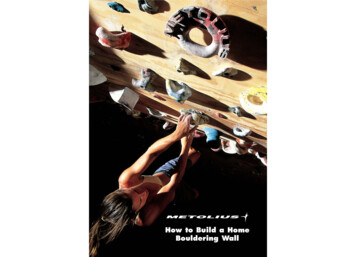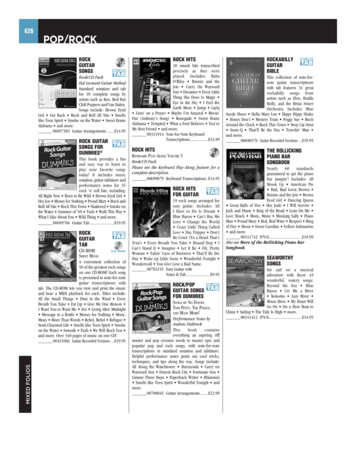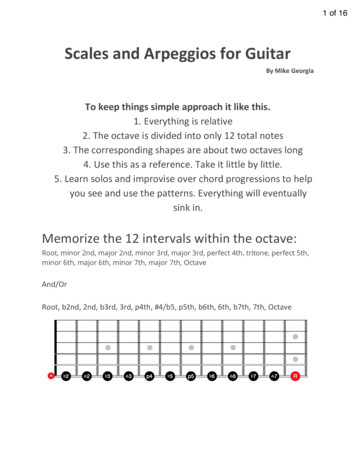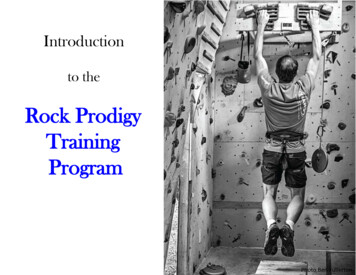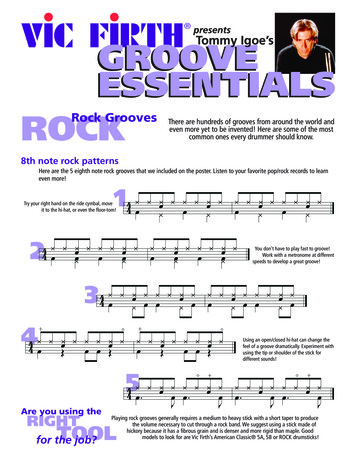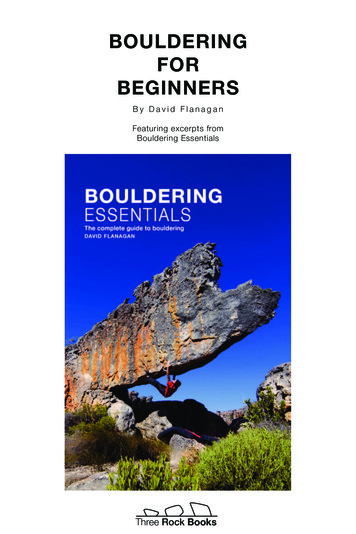
Transcription
BoulderingForBeginnersBy David FlanaganFeaturing excerpts fromBouldering EssentialsThree Rock Books
This free ebook is aimed at those newto bouldering - indoors or outdoors. Itcontains everything you need to know toget started from explaining what bouldering is, describing how to stay safe, adviceon choosing the right equipment to tips forbouldering outdoors on rock for the firsttime.This ebook’s contents are abbreviated andexcerpted from the print book Bouldering Essentials which runs to192 pages and is packed with lots moreinformation on the topics addressed in thisebook as well as many other slightly moreadvanced topics such as movement, dynamics, strategy, training and destinations.The print book also contains over 200stunning photos from the best bouldering areas in the world includingBishop, Castle Hill, Fontainebleau,Hueco Tanks and Rocklands, Bouldering Essentials provides theinspiration and information you needto reach your full potential as a boulderer.Find out more about Bouldering EssentialshereISBN 978-0-9567874-1-5Author David FlanaganFormat Paperback (192pp)Price 25 (including delivery)
Reviews of Bouldering Essentials“If you are in your early stages of climbing or know someone who is keen to learn moreabout this sport then I couldn’t recommend this book enough. Even if you have been bouldering a long time it is a useful coffee table aid to help explain to non climbing friends exactlywhy it is you don’t just walk round the back all the time.”Dan Varian, UK Climbing“I can’t recommend this book enough for the boulderer starting out on the whole adventure- I wish I’d had it twenty years ago. I’d have been a better climber, I’d have touched muchmore rock and I’d probably have burnt my ropes.”John Watson, Stone Country Press“They say a core part of the coach’s role in any sport is to inspire and motivate. Flanaganhas clearly taken this on board, and the obvious effort spent on perfecting the visual appealof Bouldering Essentials has paid off.The array of world class photos is one of the book’sgreat strengths.It’s like the book version of your mate who climbs several grades harderthan you – there to offer tips, help with tactics and show you the next level really is possible.“Dave Westlake, RockAndRun.com“Bouldering Essentials succeeds in not only telling how to play but also inspires to get outthere and do it. If you were wondering what to get your bouldering-curious new boyfriend forChristmas, now you know. “Duncan Critchley, UKBouldering.com“Bouldering Essentials. covers all the basic to advanced training and the focus is definingand describing everything. You can more or less start anywhere and start reading/learning.All-in-all, a good book for the ones who want an informative bouldering book that will makeyou understand everything the advanced boulderers are talking about during a boulderingsession or trip.”Jens Larssen, 8a.nu“Designed to cater to all, from experienced boulderers to complete novice climbers to thosewho may climb in other disciplines (traditional, sport, etc) and interested in trying their handat this type of climbing, there is a wealth of information to delve into.Throughout the book,there is beautiful photos used to tempt and inspire.”Neal McQuaid, Irish Mountain Log“Bouldering Essentials is a must have book for anyone remotely interested in bouldering, itslike a bible for boulderers.”Ian Fisher, DiscoverBouldering.com
ContentsIntroduction 7Equipment 10Staying Safe 14MOVEMENT 18Indoor Climbing 26STARTING Outdoors 30Glossary 36
Bouldering is climbing without a rope onboulders, cliffs or indoor climbing wallswhere a fall is unlikely to result in injuryIntroductionClimbing is a primal human instinct and bouldering, possibly with the exception of soloing, is thesimplest, purest form of rock climbing. While soloing is high risk and only for experienced climbers,bouldering is playful and accessible to all.Rock climbing is often incorrectly perceived as anactivity that requires massive strength, but movement skills, creativity and imagination are just as, ifnot more, important.Bouldering has existed in a very informal waysince the late 19th century. And while it hasalways had its devotees, until recently mostclimbers considered it as nothing more than adistraction on wet days or as a means of trainingfor ‘real’ climbing.However, in the last two decades its popularityhas surged largely thanks to the invention of bouldering pads and indoor climbing walls and whatwas once a niche activity is now a recognisedclimbing discipline, a valid pursuit in itself with aproliferation of guidebooks, videos, indoor wallsand competitions dedicated to it.Bouldering is the climbing equivalent of the 100msprint. Risk, stamina, exposure and ropeworkare removed from the equation and the focus ison movement rather than getting to the top byany means. Bouldering requires and developsstrength, balance, flexibility, coordination, determination and problem-solving.The definition of bouldering is broad, as bouldering can mean different things to different people.It can be about pushing limits and climbing hard,getting outdoors with friends and having fun,discovering new problems or training for routeclimbing.Why Boulder?Bouldering is an excellent way to introducebeginners to rock climbing. It requires minimalequipment, it’s safe and there isn’t the distractionof ropework or fear of heights.Bouldering, and climbing in general, is quiteunique in that both sexes can compete on areasonably even footing. In bouldering it’s up toeach individual to figure out a way to climb thatis tailored to their strengths (power, flexibility, balance etc.).Later in your climbing career if you move on toother forms of climbing, the movement skills youhave learnt while bouldering will stand to you.For route climbers bouldering is an excellent wayto get stronger and improve their movement skills.It’s also a good option when the weather is toocold to stand around belaying.In these busy times bouldering is ideal for a ‘quickhit‘ of climbing. It’s a good use of limited free time,even an hour of bouldering is enough to get aworkout.Bouldering is the most social of the climbing disciplines, it’s possible to boulder alongside otherstaking turns climbing, spotting each other, sharingadvice and encouragement.FACING PAGE Dave Flanagan on the Arete Right Of The Fin,Glendalough, Ireland.Previous PAGE Diarmuid Smyth in Roundstone, Ireland.
Boulder ProblemsA bouldering route is referred to as a problem.The term reflects the fact that getting to the top isas much about figuring out what to do as actuallydoing it.At indoor climbing walls problems follow specifichand and foot holds (usually marked with tags orcolour-coded holds). A problems won’t necessarily go straight up, it may go across - a traverse - orweave over, around or under features, sometimesseeking difficulty, other times avoiding it.Most bouldering is done on boulders andoutcrops, but the base of larger cliffs and evenbuildings are used.If the cliff or boulder is very high or the rockbecomes loose or vegetated then the problemmay be considered finished at a reasonable heightrather than at the top.A bouldering pad is a rectangular crash mat thatconsists of multiple layers of foam covered in aheavy duty material. The pad is placed on theground where the climber is expected to fall so asto cushion their landing.Spotting is guiding a falling climber safely to theground. The spotter’s goal is to ensure the climberlands safely rather than to catch them in theirarms.Like most disciplines of climbing, risk in bouldering can be avoid or pursued. By choosing to stickto low problems with good landings you can stayreasonably safe or you can push your limits onhigh, difficult problems.Bear the following points in mind: The matting will cushion your fall but thisdoesn’t mean you can’t hurt yourself. Landupright, soak up the impact by bending yourlegs and rolling to the side if necessary.The Goal Don’t wear a harness while bouldering.Put at its simplest, the goal of bouldering is to getto the top. You may succeed on some problemson your first try while others can take weeks ofeffort. Bouldering has a strong sense of aesthetic,be it for the feel of a particular move, the architecture of a problem or the elegance of a solution. Remove any rings or jewellery, they could getjammed with very nasty consequences.Boulderers seek out problems that are enjoyable to climb, this may be because they take animpressive route up the boulder, have some reallynice holds or very interesting movements. Always give way to any climber that is higheron the wall than you.Some problems reflect the playful aspect ofbouldering, for example those that are solved by arunning jump, a leap from an adjacent boulder orwithout using the hands.SafetyBouldering is one of the safest forms of rockclimbing and serious injuries are rare. However,it should be considered low risk rather than riskfree.As boulderers don’t use a rope to protect themselves they rarely climb high above the ground.The average boulder problem is about four metreshigh. This mightn’t sound like much, but often thelanding area is uneven or rocky and falls can happen very suddenly from awkward positions.Boulderers minimise the risk of getting hurt in a fallby using bouldering pads and by spotting eachother. Watch out for anyone underneath you whileyou are climbing and stay alert when walkingaround. Don’t sit or lie around on the mats. Children should be watched closely, theycould be seriously injured by a falling climber.FACING PAGE Peter McMahon on Highawatta, Derryrush,Ireland.
Equipmentsandy or muddy conditions and a guidebook tohelp you find your way around the boulders.Bouldering doesn’t require much equipment, toclimb indoors all you need are climbing shoes andmaybe some chalk.If you are venturing off the beaten track, youshould also take a map and compass, food,water, warm clothes and a head torch.Climbing shoes are tight fitting with soles ofsmooth sticky rubber that make standing on smallor sloping foot holds much easier. However, theyaren’t absolutely essential, and most climbingwalls hire shoes.Climbers use chalk to absorb the sweat on theirhands, you might find it useful as well.Wear loose fitting but not overly baggy clothes.Walls can be cold so wear lots of thin layers sothat you can shed layers as you warm up.One of bouldering’s many attractions is that itdoesn’t require a lot of equipment. All you needare climbing shoes, a chalk bag and, if you boulder outdoors regularly, a bouldering pad.There are a few other less essential but usefulitems such as: a small patch of carpet or doormatto keep your shoes clean and dry before you steponto a problem, a tarp to protect your pad in wet,ChalkChalk (Magnesium Carbonate, MgCO₃) is a whitepowder that absorbs sweat from a climber’shands. Most boulderers find it indispensable asboth a practical and psychological aid. Whilechalk doesn’t increase friction, it prevents sweatreducing it (see page Bouldering Essentials formore information about friction).Some chalk contains a drying agent that is helpful if you have sweaty hands or climb in a warmclimate, but be careful that your skin doesn’tbecome too dry.Chalk is available as powder, chalk balls andliquid. Chalk balls are round mesh bags filled withchalk. While they reduce the amount of airbornechalk they aren’t very effective and the chalktends to be very fine and talc-like.
Liquid chalk is a mix of chalk and alcohol thatevaporates once rubbed into the hands leaving agood coating of chalk. It’s useful as a base layeror if you can’t use chalk (for example when training at home).moves. A pair of gloves or mittens are thebest way to get the warmth back into them. A breathable base layer with long sleeves willdry faster and keep you warmer than a cottonT-shirt.Use chalk sparingly, excessive amounts won’timprove grip and non-climbers may consider rockthat is caked in chalk unsightly. A fleece or wool jumper makes for a goodmid-layer. If it’s cold you might need to wear itwhile climbing so make sure it isn’t too restrictive or bulky.Chalk Bag When it’s cold nothing beats a down jacket(see above), they are an essential item forbouldering in winter. A decent hood makes abig difference on those really freezing days.A chalk bag (see above) is a small pouch for holding chalk, that is designed to be hung on a belttied around the waist. When you can’t or don’tneed to chalk up mid-problem leave it on theground to prevent spillages.Chalk buckets are large chalk bags designed tobe left on the ground and they are more suitablefor indoor bouldering.An airtight bag or box is useful for storing yourchalk and chalk bag as it tends to get everywhere.Clothing Nearly any trousers will do as long as theydon’t restrict your movement. Rolling up theends gives a better view of the feet. In warmweather shorts will keep you cool but don’toffer protection from rough rock, insects orundergrowth. It’s rare to see a boulderer wearing socks under their climbing shoes, but if it’s really cold athin pair can work. Hiking boot are great for long walk ins overrough ground. They will keep your feet warmand dry, provide good support for your anklesand if looked after properly will last for years.BrushExcess chalk is easily removed with a brush (seeabove). There are a variety of fancy boulderingbrushes on the market, however a plastic bristledwashing-up brush works just fine.Some climbers use a telescopic pole with a brushattached to the end to clean out of reach holds.Alternatively, just tape your brush to a stick.Never use a wire brush as the metal bristles destroy the rock. For more about cleaning problemssee Bouldering Essentials.Skin CareWhen you are bouldering a short walk from thecar and the weather is good there is no need forany specialist clothing, but if you are walking to aremote area or expect cold or wet weather thenthe right clothing is essential to get the most outof the day. Hats add warmth without restricting movement. Make sure it covers the ears. Cold rock can numb fingers after only a fewThe following are worth carrying, especially ontrips, to keep your skin in good condition: Finger tape - zinc oxide tape. Fine sandpaper or a pumice stone. Moisturiser.
Bouldering PadUntil the mid-nineties, when bouldering padswere invented, even short falls hurt. Pads havemade falling off much more comfortable and havedramatically reduced the chances of injury. As aresult the popularity of bouldering has soared.Pads opened up problems and areas with rockylandings that previously could have badly injuredany climber who fell. Nowadays it’s not unusual tosee a half dozen pads beneath a problem with abad landing.Pads not only reduce the chance of injury from afall, they protect against long-term damage to theknee, foot and ankle joints which can result fromrepeated falls.There are lots of different designs, but fundamentally a pad is just a few layers of foam covered in ahard-wearing fabric.Most pads consist of a thick layer of soft foamand a thinner layer of hard foam. The hard foamis usually on top (i.e. the side you land on) as thisspreads the impact which is then absorbed bythe soft foam. On low, steep problems it can bebetter to face the soft foam up to soften a shortfall onto your back.Pads vary in sizes from small circuit or launchpads (1m x 1.5m x 5cm thick) to monstroushighball pads (3m x 2m x 15cm thick). The mostsuitable size depends on the type of boulderingyou do, how big your car is, how long the walkin etc.Very large pads have their uses, but most peoplewill find two smaller pads more useful.The most costly part of a pad is the foam. Goodquality foam that will stay stiff for a reasonablelength of time is expensive. All foam has a limitedlife after which it becomes very soft, so if you useyour pad a lot you might need to replace the foamevery few years.Bouldering pads come in two styles: taco andhinge. Taco pads (see above right) consist of onecontinuous section of foam that bends in themiddle for carrying while a hinge pad (see aboveleft) consists of two sections of foam joined by afabric hinge.
ToeShoesOutside edgeInside edgeThere is a wide range of climbing shoes on themarket, many of which are designed specificallyfor bouldering.When choosing the best shoe for your needsyou must compromise between many differentfactors, such as: A tight fit gives better performance on smallholds at the expense of comfort.ARCH The stickier the rubber, the faster it will wearout. Stiff shoes ‘edge’ well but ‘smear’badly. Thin soles are more sensitive but lessdurable.Most beginners’ footwork is such that their firstpair of shoes don’t last long, so there is no pointspending a fortune on them.RandFitThe rule of thumb for climbing shoes is: thetighter the fit, the better the performance. Mostboulderers wear climbing shoes a few sizessmaller than their street shoes.Fit your shoes so that they are snug but not sotight that your feet are in agony, bear in mindthey will stretch and mould to your feet to someextent (synthetic uppers won’t stretch, linedleather uppers will stretch a small bit and unlinedleather can stretch up to a full size).Make sure that there isn’t any dead space in theshoe, particularly around the heel.Shoes with thin soles and minimal lining performbest with a snug fit, while shoes with stiffer solesdon’t need to be fit too tight.Some climbers wear extremely tight shoes whichforce their toes to be clenched like a fist. Thisallows them to press down hard on small edges,but it can be a disadvantage on sloping holdswhere the goal is to get as much rubber as possible in contact with the rock. It’s also not very goodfor the health of their feet.Before you climb in new shoes wear them aroundthe house for a few hours and if they are too smallyou can return them.HeelSTYLESEntry level shoes tend to be stiff with a thick layerof rubber, flat soles and plenty of room in the toearea. And while not brilliant from a performancepoint of view they are comfortable and relativelycheap.High performance shoes feature an extremelydown turned toe (for better edging on steep rock),very thin sticky soles and extra rubber on the topand side of the foot for ‘toe hooking’ and smearing. They can be quite uncomfortable, especially ifa tight fit, and are only really suitable for experience climbers operating at a high level.Which closure systems (velcro, lace or slipper) isdown to personal preference.
Staying SafeSpottingBouldering is a relatively safe activity and seriousinjuries are rare, but precautions still need to betaken.Spotting should be taken as seriously and donewith just as much care and attention as belaying.A good spotter gives the climber the confidenceto focus completely on the moves.HighballsHighballs are tall boulder problems, they occupythe middle ground between problems and routes.Highballing is not recommended for beginnersas, to be done with a reasonable safety margin, itrequires a lot of experience, good judgement anda cool head.Down-climbingWhen you are high above the ground downclimbing is a safer option than falling or jumping.It’s a skill that requires practice and certain typesof moves such as dynamics and mantels can bevery difficult, if not impossible, to reverse.Plan AheadSpend a few moments before you start up aproblem thinking about where and how you arelikely to fall. This will help you decide where toposition the pads and spotters. As you makeprogress on a problem and learn more aboutthe moves, reposition the pads and spotters asnecessary.Loose or Dirty RockNever let your guard down when climbing orspotting as you never know when a hand or footcould slip or a hold break. Give every problem, nomatter how easy, 100% concentration until youhave reached the top.Holds typically break when you are pulling hardon them, resulting in very dangerous, explosivefalls. Big storms and freeze thaw action canloosen previously solid holds. Some rock types,particularly sandstone, are fragile when damp soalways allow them plenty of time to dry out beforeclimbing on them.In all but the most popular bouldering areas youwill encounter dirty or vegetated rock. Loose crystals or grains of sand act like ball bearings, causing the hands and feet to slip without warning.The primary goal of spotting is to protect theclimber’s head from an impact. The spotter isn’texpected to catch the falling climber in their arms,only to guide them onto the pads, break their falland ensure they land upright and in balance.When spotting use a wide, firm stance with yourhands reaching towards the climber’s midriff.Stand a few feet beyond the point where youexpect the climber’s feet to hit the ground.Focus your attention on the area just above thehips rather than watching the hands or feet anddon’t get distracted pointing out holds or studyingthe moves.Once the falling climber reaches your outstretchedarms, guide them to the pad and away from anyhazards. Keep a firm grip on them until they haveregained their balance.On slabs and vertical walls the climber will eitherslide or fall with their body upright so all the spotter needs to do is steady the climber once theyhit the pad.On steeper rock the climber is likely to fall withtheir body at an angle and the danger is that theywon’t land on their feet. The spotter can helpby making contact slightly higher on the fallingclimber’s torso, rotating them into a more uprightlanding position.Pay very close attention on problems that requirefoot cams, kneebars or heel hooks as if a limbgets jammed it could get seriously damaged, aswell as tipping the climber over so they fall headfirst.FACING PAGE Ricky Bell on Leftisim, Glendalough, Ireland.
FallingIt’s impossible to push your limits without falling,so it’s an essential part of bouldering. Injuries fromfalls seem to occur almost randomly: some climbers are unlucky and break their ankle dropping afew feet onto a pad, while others walk away frommassive falls onto terrible landings.Landing with bad technique can lead to injuriesbut can also cause problems with your feet,ankles and knees in later life.By making sure that you are familiar with the landing zone before you start climbing, you increaseyour chances of landing well even if you fall offunexpectedly.How to FallA 3m fall lasts just over three quarters of a secondand you will be travelling at 27 kmph when youhit the ground. That doesn’t give you a lot of timefor conscious thought, you are relying entirely onyour reflexes.As you fall keep your torso vertical, your legsstraight but not locked out, your toes pointed tothe ground and your arms raised to reduce therisk of injuring your spotter.Bend your legs as you hit the ground to absorbthe impact, but avoid sinking into a deep squatposition as it’s very bad for the knees and you riskkneeing yourself in the face.Your legs won’t be able to absorb all the impactof long falls so as you bend your legs, dropsideways onto the pad with your knees, hips thenshoulders. It’s a little undignified but a lot betterthan a broken ankle.Falling on SlabsOn low angled slabs you will slide rather than fall.Sliding is safer as it’s slower and more controlled,especially on blank slabs where there is nothingto trip over. The trick is to keep your palms flatagainst the rock and to stay relaxed.Another option is to turn around and run downthe slab, this works well if the landing zone islarge and flat but it has the potential to go badlywrong.
Indoorsbefore you try it outdoors.Indoor walls are a forgiving environment but youneed to be constantly on alert for people walkingor standing under you while you climb.HelmetThe wall is the ideal place to develop good fallingtechnique, so rather than relying on the mattingto absorb the impact, land properly (bendingthe legs and rolling if necessary) like you wouldoutdoors.JumpingTactical retreat in the form of a controlled jump isoften wiser than risking an out-of-control fall.On steep problems it’s just a matter of hangingfrom the arms and dropping straight down ontothe pads.If the problem isn’t overhanging, you will have tojump slightly outwards to make sure you clear thebase of the rock. It’s much safer to land facingthe direction you are travelling (ie. away from therock), so as you jump turn, push off with a handif necessary. Practise this technique at the wallBoulderers rarely wear helmets but there maybe times when it’s a good idea. John Sherman,American bouldering guru, wears a skateboardinghelmet which he believes is better suited to thetypes of impacts in bouldering.Above Diarmuid Smyth greases off Marie Rose, Bas Cuvier,Fontainebleau, France.
MOVEMENTMovement is both the foundation and the keystone of bouldering. And while it’s possible to trainhard, get strong and climb some hard problems,without good technique, you will never reach yourfull potential as a climber.The temptation is to believe that improving issimply a matter of getting stronger and being ableto pull harder on smaller holds, but a beginner’sfocus should be on learning good movement skillsrather than building strength. This gives a solidfoundation on which to progress as a climber andallows the muscles and tendons time to adaptgradually to the stresses of bouldering, reducingthe risk of injury.Even through every boulder problem is unique,some techniques and movements that occurfrequently can be trained and practised, much likea gymnast trains on different apparatus.Familiarity with the basic moves and techniquesof rock climbing is equivalent to knowing how thepieces move in chess. It’s only a starting point forreally learning how to climb.Never be afraid to experiment and try new things.This is the beauty of bouldering, you are free toattempt moves that would be inconceivable on aroute.This freedom to experiment in safety and comfort- thanks to indoor walls and bouldering pads has allowed the modern boulderer to discard theold ‘three points of contact at all times’ rule, andmake frequent use of momentum.However, there are situations when the old rule of“three points of contact at all times“ is relevant, forexample on highballs where a fall could be dangerous or when the holds are very small and yourweight must be distributed over as many points ofcontact as possible.This section only touches on some of the basicsof climbing movement, it’s a huge topic - themovement chapter in Bouldering Essentials isover 60 pages long - and is impossible to cover injust a few pages.Improving TechniqueEven though climbing is a very natural, instinctiveactivity it still takes a lot of time and effort to reachyour full potential as a climber.Without a doubt, outdoor bouldering is the bestway to learn and hone technique. Having saidthat, bouldering outdoors can be intimidating foran absolute beginner. The comfort, accessibilityand variety of an indoor wall might be more suitable for an initiation, but don’t wait too long beforeventuring out onto rock.You won’t become a better climber just by sittingon the couch reading this (or any other) book, butif you apply what you read about on these pageswhen you are out bouldering then you will be onthe right path.Evolution of MovementThe evolution of climbing movement has alwaysbeen driven primarily by technological innovationsIn the days of hemp ropes tied around the waistthe emphasis was on security of movement, threepoints of contact and always being able to reverseto the ground, falling wasn’t an option. As climbing became safer due to advances in equipment,such as dynamic ropes and sit harnesses, physical limits started to be pushed.The arrival of bolted routes and sport climbing onsteep limestone in the eighties required a wholenew repertoire of techniques. Likewise with indoorwalls and the growth of bouldering came greatleaps in climbing standards. Dynamics, oncefrowned upon as bad style, are now a vital part ofbouldering.Individual techniques also come in and out ofvogue. Before sticky rubber shoes, edging wasthe only option on face climbs, many of which arenow smeared up by modern climbers.When steep wooden training boards coveredin small edges became popular in the ninetiesboulderers naturally sought out similar problemsoutdoors. Similarly in the last decade the sloperhas become everyone’s favourite hold.Similarly modern comp-style problems whichinvolve lots of pressing and compressing largevolumes ape the current popularity of steepcompression problems on rock. Or is it the otherway around?FACING PAGE Joe Walls on The Groove, Brimstones, Ireland.
The BasicsPlan AheadHere is some movement advice for your first fewbouldering sessions.Before you start up a problem decide which handand foot holds you are going to use and in whatorder.BalanceTo climb in balance is to climb well. If you swingall over the place as you reach from hold to holdthen you need to focus on how you are positioning your body relative to your hand and foot holds.Weight on Your FeetIt’s easier said than done, but unless the rock isvery steep, your feet should bear the majority ofyour weight.FootworkKeep It StaticDynamics - jumping for holds - is a big part ofbouldering but when you are starting out, aimto reach between holds in a smooth, controlledmanner.RelaxRelax and don’t forget to breathe. If your feet arepedalling furiously and your face is bright red, youare doing something wrong. Figure out what it isand fix it.Your footwork should be deliberate, neat andquiet. Place your feet carefully and keep them stillas you transfer weight onto them. Get in the habitof using the toe rather than the arch of your shoe.Make sure you don’t over grip with your hands, itwastes energy when you need it most.A few small steps are better than one big one.Good climbers can make hard problems lookeasy. It takes years of effort to get to that level, sobe patient and enjoy the learning process.Avoid Pulling With Your ArmsYour arms hold your body in balance, upwardmovement should come fr
Climbing is a primal human instinct and boulder-ing, possibly with the exception of soloing, is the simplest, purest form of rock climbing. While solo-ing is high risk and only for experienced climbers, bouldering is playful and accessible to all. Rock climbing is often incorrectly perceived as an activity that requires massive strength, but move-


